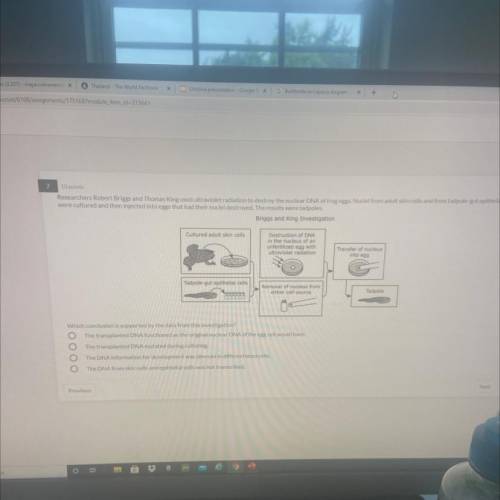
Researchers Robert Briggs and Thomas King used ultraviolet radiation to destroy the nuclear DNA of frog eggs. Nuclei from adult skin cells and from tadpole-gut epithelial cells were cultured and then injected into eggs that had their nuclei destroyed. The results were tadpoles. Which conclusion is supported by the data from this investigation?


Answers: 2
Other questions on the subject: Biology


Biology, 22.06.2019 01:00, Samuelgamboe
The sketch shows a rynchosaur, an extinct animal that is known only from fossils. there has been much debate about the classification of these creatures. some scientists suggest that they belong with primitive amphibians, and some think they are related to snakes and lizards. the data equally support both cases. which statement best explains how to draw a cladogram that includes the rynchosaur? draw the cladogram for amphibians. draw the cladogram for reptiles. draw two cladograms, both showing the traits, and leave it as a hypothesis. draw two cladograms, both showing the traits, and have scientists vote
Answers: 2

Biology, 22.06.2019 09:30, dooboose15
Along what geographical feature are most of the oil producing regions located
Answers: 1

Biology, 22.06.2019 16:30, leannesmith90101
You will create a molecular clock model for an arthropod gene. follow these guidelines to make your model: . your timeline will span from 90 million years ago to the present. the common ancestor in your model is an arthropod that lived 90 million years ago. the gene that you'll track codes for a protein in the species venom . the dna sequence youll track contains 10 nitrogen bases. you can choose the order of the bases and where the mutations occur. this gene mutates at a rate of approximately 0.76 base pairs every 17.1 million years. to build your model,/ calculate the estimated time period it takes for 1 base pair to mutate. the first time period will only show the common ancestor. at the beginning of the second time period, three lineages will diverge from the common ancestor, each with a different mutation in their gene sequences. the first and third descendant species will survive for the rest of the timeline. the second descendant species was extinct 50 million years ago. calculate how long it will take for one full base pair mutation to occur. explain your reasoning by constructing a mathematical equation
Answers: 2
Do you know the correct answer?
Researchers Robert Briggs and Thomas King used ultraviolet radiation to destroy the nuclear DNA of f...
Questions in other subjects:

Mathematics, 10.12.2019 05:31


Physics, 10.12.2019 05:31

Mathematics, 10.12.2019 05:31

Business, 10.12.2019 05:31

History, 10.12.2019 05:31

Physics, 10.12.2019 05:31


Chemistry, 10.12.2019 05:31

Mathematics, 10.12.2019 05:31






